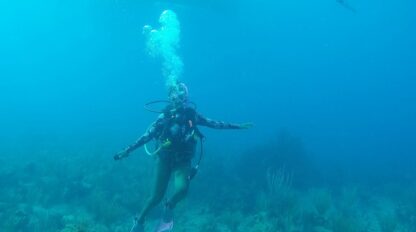Underwater Photography Guide
 Regardless of your experience level in photography and underwater exploration, combining the activities takes practice. Water covers seventy percent of Earth’s surface, yet even the most seasoned photographers may never snap a shot in the deep. Thanks to relatively recent technological advances in assisted breathing and water resistant materials, underwater photography has never been easier (and less expensive)! Here are a few simple ways to help you capture better quality images on your next dive:
Regardless of your experience level in photography and underwater exploration, combining the activities takes practice. Water covers seventy percent of Earth’s surface, yet even the most seasoned photographers may never snap a shot in the deep. Thanks to relatively recent technological advances in assisted breathing and water resistant materials, underwater photography has never been easier (and less expensive)! Here are a few simple ways to help you capture better quality images on your next dive:
Get the “Right” Camera
With the advent of digital technology, film has slid into relic status. That does not mean it is obsolete—with appropriate housing for a film camera one can capture impressive images—but it is not as easy as shooting with a digital camera.
The number of water resistant cameras available to consumers has increased exponentially in the 21st Century. It is possible to produce quality images with almost any model. A point-and-shoot gets the job done, but flexibility and quality are sacrificed a little. Digital Single Lens Reflex (DSLR) cameras will produce the best results, at a slightly higher cost. There is no “right” camera, just the camera that fits your budget and underwater activity.
Composition
With any style photography, obeying basic composition rules is key to creating an appealing focus and story you want to tell. First, place your subject in the viewfinder based on the “rule of thirds” because de-centering a subject is more interesting than keeping it dead center. Keep an eye out for attractive lines and patterns. When shooting motion, center your lens on the front of your moving subject to add anticipation. Always place yourself either level with or below your subject to get a more appealing shot. Last, keep an eye on the background and what depth of field you would like in the entire image.
What Happens to Light in Water?

Without getting too technical, it is important to know the three things that happen when light hits water: refraction, reflection, and absorption. Refraction is the bending of light rays, reflection sends them back in to the atmosphere, and specific wavelengths (colors) in the visible spectrum are fully absorbed by incremental depths (Red is only visible at shallow depths; blue much deeper). Light intensity and individual colors diminish, which forces the underwater photographer to take action in these low-light situations…
Two Lighting Options: Ambient and Flash

The only two sources of light for your pictures include the Sun (ambient) and any artificial light (flash). Both can be used effectively, but a flash affords more flexibility to the artist and increases visibility and color. Most cameras come equipped with that technology, but even a modest external strobe flash helps a camera capture far better quality images (coordinated with optimal composition, of course) than a simple, internal flash. Since Ambient light is most intense and less reflective at midday, so plan your dive accordingly if you decide on natural light.
Practice on Land
Diving is limited and expensive, so take advantage of time above sea level to play around with your camera and composition rules. The more photographs you take, the more quality images you will get. Once you’ve got it down, strap on an air tank and make the transition!

Dive! Dive! Dive!
You are now ready to jump in—go ahead! SCUBA diving should only be done with proper training and/or guidance, so if you are not a certified diver, you will need to take the PADI (or equivalent) course. You can tackle the course anywhere in the world, and there is no better place to dive than the Caribbean, Belize, or Australian coral seas.
Fill Your Memory Card (And Your Memory)
Snap Away! The more pictures you take, the more high quality images you will get. Don’t forget to look up at your subjects and not just through a viewfinder! Spend more time with underwater ecosystems and experienced divers and the photography opportunities will increase in quality and frequency.
For more complete, comprehensive underwater photography guides, check out websites by Scott Gietler, Sea Friends, and Eric H. Cheng.

